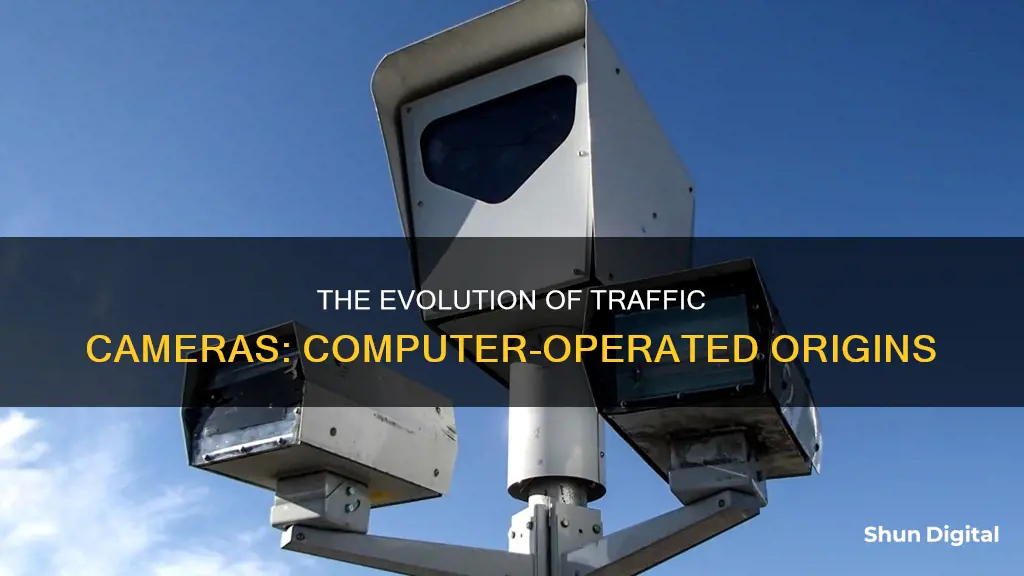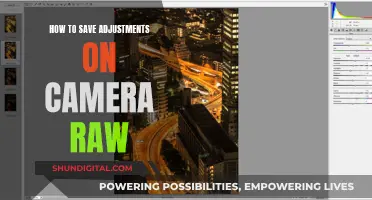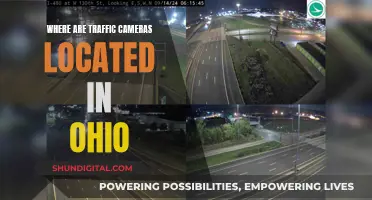
Traffic cameras have been used for decades to monitor and enforce road rules, with the first dash cam footage recorded in Vancouver, Canada, in 1907. However, the question of when traffic cameras began to be computer-operated is more complex. The first digital camera system for traffic enforcement was introduced in Canberra, Australia, in December 2000, marking a significant shift towards computer-operated technology. Since then, digital cameras have increasingly replaced older film-based systems, improving efficiency and enabling automated functions. While some jurisdictions still use film cameras for specific purposes, the trend towards computer-operated traffic cameras is undeniable, enhancing road safety and law enforcement capabilities worldwide.
| Characteristics | Values |
|---|---|
| First in-car video | 1907 |
| First police in-car video | 1939 |
| First red light camera | 1965 |
| First digital red light camera | 2000 |
| First speed camera systems in the US | 1986 |
What You'll Learn

The first traffic cameras
The history of traffic cameras can be traced back to the late 19th century, with the 1894 science fiction novel "A Journey in Other Worlds" describing "instantaneous kodaks" used by police to enforce speed limits. However, the development and use of traffic cameras as we know them today have evolved over the decades, with many pioneers and innovations along the way.
One of the earliest known instances of what could be considered a "dash cam" was recorded in 1907 by William Harbeck, a filmmaker from Toledo, Ohio. Harbeck used a hand-crank camera to capture moving footage of everyday life on the streets of Vancouver, Canada, marking a significant step towards the concept of traffic cameras. Unfortunately, Harbeck's life was cut short when he perished aboard the Titanic while documenting its maiden voyage.
In 1926, a camera was mounted on a fire chief's vehicle in Brooklyn, capturing what is believed to be the first footage of a call-out from start to finish. This was followed by the first police dash cam footage in 1939, when California Highway Patrol Officer R.H. Galbraith mounted a motion-picture camera on his patrol car's dashboard to capture potential traffic violations.
In 1965, the world's first red light camera system was introduced by Gatsometer BV, using tubes stretched across the road to detect violations and trigger the camera. These early systems used film, which was later replaced by digital technology. Gatsometer BV, founded by rally driver Maurice Gatsonides, also introduced the first radar for use with road traffic in 1971 and the first mobile speed traffic camera in 1982.
The use of traffic cameras gained serious attention in the United States in the 1980s, particularly after a highly publicized crash in 1982 involving a red-light runner in New York City. This incident sparked a community effort to work with the city's Department of Transportation to research and implement automated law-enforcement systems to identify and ticket drivers who run red lights.
The deployment of traffic cameras has sparked debates around privacy and the potential for government surveillance of vehicle movements. While some argue that traffic cameras improve road safety and reduce accidents, others contend that their primary purpose is financial gain through ticketing. Additionally, there are concerns that red light cameras may cause more sudden stops, increasing the risk of rear-end collisions.
Today, traffic cameras are an integral part of intelligent transportation systems, providing real-time monitoring and aiding in law enforcement, traffic management, and road safety.
SmackDown vs. Raw: Who Has Better Camera Work?
You may want to see also

The evolution of traffic cameras
Traffic cameras are video cameras used to observe vehicular traffic on roads. They are distinct from road safety cameras, which are installed to enforce road rules by taking still photos of violations. The use of traffic cameras has evolved over the years, from early video surveillance systems to modern digital and computer-operated cameras. Here is a brief history of the evolution of traffic cameras:
The early years
The concept of speed cameras dates back to the late 19th century, with the idea appearing in science fiction novels. However, the first "dash cam" footage was captured in 1907 by a filmmaker from Ohio, who recorded moving images of everyday life in Vancouver, Canada. In 1926, a camera was mounted on a fire chief's car in Brooklyn, capturing footage of a call-out. The following year, in 1927, an early mechanical closed-circuit television (CCTV) system was developed by Russian physicist Léon Theremin, which was installed in the Moscow Kremlin to monitor visitors.
The development of traffic cameras
In the late 1930s, the first police dash cam footage was captured in California. In 1939, a California Highway Patrol Officer mounted a motion-picture camera on his patrol car's dashboard to record potential traffic violations. In 1942, Siemens AG installed a CCTV system in Nazi Germany to observe the launch of V-2 rockets. The first commercial closed-circuit television system became available in the US in 1949, known as "Vericon". During the 1950s and 1960s, the Dutch company Gatsometer BV, founded by rally driver Maurice Gatsonides, produced the 'Gatsometer', which was later used as a police speed enforcement tool.
The introduction of digital technology
In the 1970s, video surveillance systems began to be used more widely, although they required constant monitoring as there was no way to record and store information. The development of reel-to-reel media and VCR technology improved the ability to record and store footage. In the 1980s, red light camera usage expanded worldwide, with companies like Poltech International supplying camera systems to Australia, Britain, South Africa, and more. Initially, these systems used film, but the first digital camera system was introduced in Canberra in 2000, marking a shift towards digital technology.
The rise of computer-operated cameras
With advancements in digital technology, traffic cameras began to be linked to computer systems for data storage and analysis. In the 1990s, digital multiplexing was developed, allowing multiple cameras to record simultaneously and enabling time-lapse and motion-only recording. This increased the efficiency and cost-effectiveness of traffic cameras. The 2000s saw a rapid growth in the use of digital and computer-operated traffic cameras, with improvements in resolution and the introduction of high-definition and 4K cameras. Today, traffic cameras are widely used in many countries and have become an integral part of road safety and law enforcement.
Surveillance Footage Retention: How Long is Too Long?
You may want to see also

Traffic cameras and privacy
Traffic cameras are a common feature of roads, especially highways, freeways, expressways, and arterial roads. They are distinct from road safety cameras, which are installed to enforce road rules by capturing still photos of vehicles breaking the law. In contrast, traffic cameras are used for observation, continuously capturing lower-resolution videos of traffic flow. These cameras are often mounted on high poles, masts, or streetlights, and are connected by optical fibres with a power supply.
While traffic cameras are valuable tools for monitoring and improving road safety, their use has also raised privacy concerns. The following discussion will explore the topic of traffic cameras and privacy in detail.
The Benefits of Traffic Cameras
Traffic cameras are essential components of intelligent transportation systems, providing real-time video footage to monitoring centres. This enables quick responses to traffic collisions and other incidents, improving road safety and management. They are particularly useful in tunnels, where they can activate safety equipment remotely. Additionally, traffic cameras can be utilised for video tolling, where license plate recognition technology is used to bill motorists.
Privacy Concerns
The use of traffic cameras has sparked debates about government surveillance and privacy. Some critics argue that these cameras can be used for mass surveillance of vehicle movements, which indirectly tracks the movements of vehicle owners. This raises concerns about the potential misuse of data and the invasion of privacy. For instance, the American Civil Liberties Union (ACLU) in the US has opposed the use of speed cameras, claiming that they can be used as a revenue source rather than solely for safety purposes.
Addressing Privacy Concerns
To address privacy concerns, measures can be implemented to ensure the responsible use of traffic camera data. For example, access to collected data can be restricted to authorised personnel, such as trained law enforcement staff and relevant government agencies. Additionally, data retention policies can be established, specifying that data must be deleted within a certain timeframe if it is not used for a specific purpose.
Striking a Balance
While traffic cameras can enhance road safety, it is crucial to respect individuals' privacy rights. By implementing robust data protection measures and ensuring transparency in the use of traffic camera data, a balance can be achieved between public safety and privacy preservation.
Inserting a Battery Pack: DX4530 Camera Guide
You may want to see also

Traffic cameras and public perception
Traffic cameras have been a source of controversy since their introduction in the 1960s, with concerns over their effectiveness, accuracy, and potential for revenue generation. Despite this, public support for these technologies remains strong, with citizens acknowledging their potential to improve road safety and save lives.
Effectiveness and Safety
Traffic enforcement cameras are widely recognised for their ability to enhance road safety and reduce accidents, injuries, and fatalities. Studies have consistently demonstrated the positive impact of these technologies on road safety, with reports of significant reductions in collisions and casualties. For example, a four-year automated speed enforcement camera program in the UK led to a 43% decrease in fatalities and a 29% reduction in pedestrian injuries in areas with traffic cameras.
Accuracy and Reliability
The accuracy and reliability of traffic cameras play a crucial role in maintaining public trust. High accuracy rates minimise public frustration and ensure that any violations are properly justified by authorities. Negative perceptions can arise if the cameras are unreliable or have poor capture accuracy, leading the public to view the technology as solely money-grabbing.
Revenue Generation
Public suspicion often arises due to the potential for traffic cameras to generate revenue for local authorities. This perception can be mitigated by ensuring transparency in the use of any excess revenue. Some municipalities address this concern by allocating revenue from traffic fines to fund other traffic safety projects, such as pedestrian crossings and safety campaigns.
Privacy and Surveillance
The increasing use of traffic cameras has also raised concerns about privacy and surveillance. This includes the potential for governments to track vehicle movements and, by association, the movements of vehicle owners. This issue is particularly sensitive for marginalised communities, who may have existing distrust in governing bodies and surveillance systems.
Communication and Transparency
Clear and transparent communication about the purpose and implementation of traffic camera programs is essential for maintaining positive public perception. Keeping the public informed about the locations of cameras, the use of revenue, and the results of program evaluations helps build trust and accountability.
Media Representation
Media reports and exposure significantly influence public opinion about traffic camera programs. Positive media coverage, such as highlighting the reduction in road accidents, can maintain public support. Conversely, negative media framing, such as portraying the program as a "cash grab," can lead to a decline in public reception.
In conclusion, while traffic cameras have faced public scrutiny, a careful and responsible approach to their deployment, focusing on safety, transparency, and accountability, can lead to positive public perception and support for these life-saving technologies.
Understanding Camera Battery Labels: S and T Explained
You may want to see also

Traffic cameras and road safety
Traffic cameras are video cameras that observe vehicular traffic on a road. They are typically installed along major roads such as highways, freeways, expressways, and arterial roads. These cameras are distinct from road safety cameras, which are installed at specific locations to enforce road rules by capturing still photos of violations. Traffic cameras, on the other hand, are meant for observation and continuously record lower-resolution videos. They are often mounted on high poles, masts, or traffic light poles, especially at intersections where problems are most likely to occur.
The use of traffic cameras has been shown to be highly effective in improving road safety. They can be used to monitor and enforce safe driving practices, reducing the risk of accidents and promoting overall road safety. Research has demonstrated that traffic cameras can reduce red-light violations by up to 40% at intersections where they are installed. Additionally, there was a 24% reduction in fatal accidents caused by red-light violations in cities with traffic cameras. The use of these cameras has also been successful in various municipalities across the United States. For example, in Seattle, the implementation of traffic cameras resulted in a 30% reduction in red-light violations and a 42% reduction in accidents caused by such violations. Similarly, in Chicago, the use of traffic cameras led to a 19% reduction in fatal accidents caused by red-light violations.
Speed safety cameras (SSCs) are a type of traffic camera that can be used to enforce speed limits effectively. They can be deployed as fixed units, point-to-point units, or mobile units. SSCs have been shown to reduce crashes on urban roads, with fixed units reducing crashes by up to 40%, point-to-point units by up to 50%, and mobile units by up to 35%. In New York City, fixed units reduced speeding in school zones by up to 63% during school hours.
While traffic cameras have proven benefits for road safety, there are also challenges and controversies associated with their use. One of the main challenges is cost, as these cameras can be expensive to install and maintain. There are also concerns about privacy and civil liberties, with some groups arguing that the widespread use of traffic cameras could lead to mass surveillance of vehicle movements and, by association, the movements of vehicle owners. Additionally, there have been accusations that traffic cameras are being used primarily as a means of generating revenue for local governments rather than for promoting safety on the roads.
To address these challenges, it is important to ensure that traffic cameras are used for their intended purpose of promoting safety. This can be achieved by setting clear guidelines for their use and monitoring their implementation. Additionally, agencies should conduct regular evaluations to determine if the cameras are meeting safety goals and make necessary adjustments. By taking these steps, the benefits of traffic cameras in improving road safety can be maximized while also addressing privacy and cost concerns.
Speeding Ticket Camera Fines in Maryland: How Much?
You may want to see also







